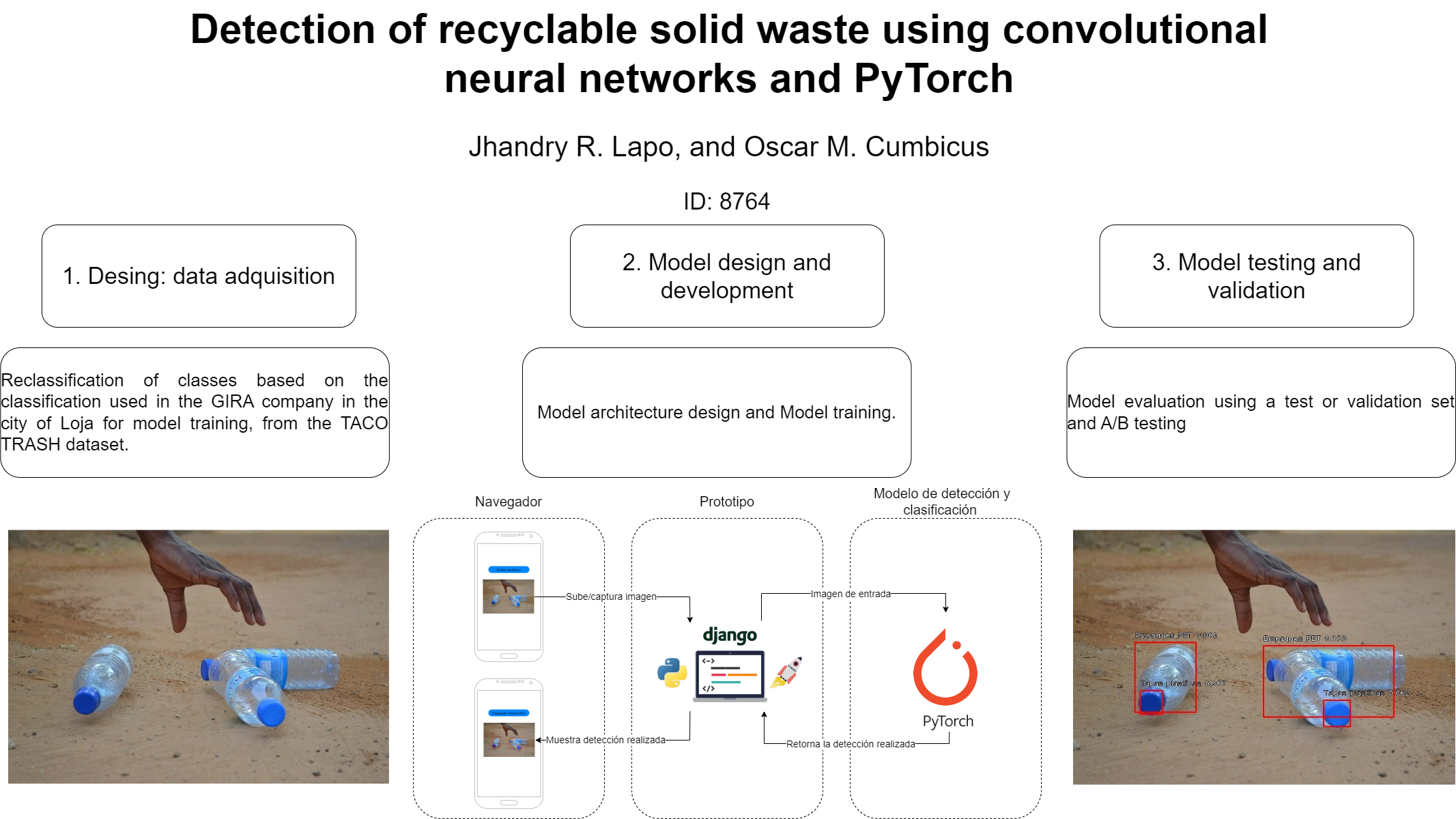Detection of recyclable solid waste using convolutional neural networks and PyTorch
Keywords:
Computer vision, Image classification, Object detection, convolutional neural network, EnvironmentAbstract
Waste management in the recycling business is a time-consuming and labor-intensive process. In this context, the need to improve accuracy and reduce the time associated with this process is highlighted. In order to improve the classification of recyclable solid waste and streamline the waste management process, the creation of a convolutional neural network (CNN) model using PyTorch was proposed. The MLOps methodology was implemented in the development of the proposed model. In the first phase, an interview was conducted to analyze the waste sorting process in the company GIRA. In the second phase, the Taco Trash Dataset was reclassified, a CNN architecture based on RetinaNet was designed and the model was trained with hyper parameters based on related works. The third phase, the model was evaluated by testing and A/B testing. The model demonstrated high accuracy in waste detection and classification. It successfully identified materials such as paper, cardboard, PET bottles, hard plastic containers, flexible plastics, cans, glass, Tetra Pak containers, Flex foam and PET bottle caps. The loss was minimal, reaching 0.02120%, equivalent to 97% accuracy, and 80% accuracy in a real environment based on the Technology Acceptance Model (TAM). It is concluded that the implementation of a sorting and waste detection model optimizes the time and improves the accuracy of the sorting process.
Downloads
References
L. Abarca-Guerrero, G. Maas, y W. Hogland, “Desafíos en la gestión de residuos sólidos para las ciudades de países en desarrollo”, Revista Tecnología en Marcha, vol. 28, núm. 2, p. ág. 141-168, jun. 2015, doi: 10.18845/TM.V28I2.2340.
S. Albawi, T. A. Mohammed, y S. Al-Zawi, “Understanding of a convolutional neural network”, Proceedings of 2017 International Conference on Engineering and Technology, ICET 2017, vol. 2018-January, pp. 1–6, mar. 2018, doi: 10.1109/ICENGTECHNOL.2017.8308186.
T.-B. Centeno et al., “Herramientas de corte para optimizar parámetros de clasificación de especies maderables con redes neuronales convolucionales”, Rev Biol Trop, vol. 71, núm. 1, ene. 2023, doi: 10.15517/REV.BIOL.TROP..V71I1.51310.
J. R. Lapo Jima, “Detección de residuos sólidos reciclables utilizando redes neuronales convolucionales y PyTorch”, Bachelor Thesis, Universidad Nacional de Loja , Loja, 2024.
H. Abdu y M. H. Mohd Noor, “A Survey on Waste Detection and Classification Using Deep Learning”, IEEE Access, vol. 10, pp. 128151–128165, 2022, doi: 10.1109/ACCESS.2022.3226682.
J. Giraldo, “Clasificador de residuos sólidos haciendo uso de deep learning.”, Bachelor Thesis, Universidad Autónoma de Occidente, Santiago de Cali, Colombia, 2022, https://hdl.handle.net/10614/14209.
P. F. Proença y P. Simões, “TACO: Trash Annotations in Context for Litter Detection”, mar. 2020, doi:10.48550/arXiv.2003.06975.
V. Dewufl, “Application of machine learning to waste management: identification and classification of recyclables”, 2017, doi: 10.13140/RG.2.2.26805.50406.
J. O. Lim, “Comparison of Re-trained CNN Models from Pytorch , Keras, and Tensorflow Frameworks for Image Waste Classification”, Theses and Dissertations (All), ene. 2019.
S. Karthikeyan, M. Sivakumar, A. Jeysiva, y C. Maheshkumar, “Application of Deep Learning for Solid Waste Trash Classification using Deep CNN”, pp. 126–131, 2021.
F. Núñez, “Dry Waste Segregation using Computer Vision”, Proceedings of the 2022 39th IEEE Central America and Panama Student Convention Conference, CONESCAPAN 2022, 2022, doi: 10.1109/CONESCAPAN56456.2022.9959238.
M. S. Saavedra Mayorga, “Implementación de un sistema de detección de residuos reciclables basado en visión computacional”, Bachelor Thesis, Universidad de Chile, Santiago de Chile, Chile, 2020, https://repositorio.uchile.cl/handle/2250/178007.
M. Salina, “Deep Learning aplicado al procesamiento de imágenes para la detección de objetos reciclables.”, Bachelor Thesis, Universidad Nacional Arturo Jauretche, Buenos Aires, Argentina, 2021, https://biblioarchivo.unaj.edu.ar/mostrar/pdf/scvsdf/erwe/fc8a4f46c475c1313b5355ff638ccbf653637aed.
G. E. Sakr, M. Mokbel, A. Darwich, M. N. Khneisser, y A. Hadi, “Comparing deep learning and support vector machines for autonomous waste sorting”, 2016 IEEE International Multidisciplinary Conference on Engineering Technology, IMCET 2016, pp. 207–212, dic. 2016, doi: 10.1109/IMCET.2016.7777453.
D. L. G. Vargas y A. K. T. Saavedra, “Clasificador de residuos sólidos para la i.e. Juan XXIII del municipio de Algeciras con aplicación de Machine Learning”, Revista Sennova: Revista del Sistema de Ciencia, Tecnología e Innovación, dic. 2022, doi: 10.23850/23899573.5409.
M. Satvilkar, “Image Based Trash Classification using Machine Learning Algorithms for Recyclability Status”, Master's Thesis, National College of Ireland, Dublin, 2018, https://norma.ncirl.ie/3422/.
R. Sultana, R. D. Adams, Y. Yan, P. M. Yanik, y M. L. Tanaka, “Trash and Recycled Material Identification using Convolutional Neural Networks (CNN)”, Conference Proceedings - IEEE SOUTHEASTCON, vol. 2020-March, mar. 2020, doi: 10.1109/SOUTHEASTCON44009.2020.9249739.
J. M. Peña Lorenzo, “Aplicación de técnicas de aprendizaje profundo (deep learning) para la detección de objetos en Industria 4.0”, Master's Thesis, Universidad de Valladolid, Valladolid, España, 2020, http://uvadoc.uva.es/handle/10324/43255.
J. F. Guerrero Citelly, “Traductor de lenguaje de señas portatil por medio de reconocimiento de imágenes”, Bachelor Thesis, Universidad de los Andes, Colombia, 2018, http://hdl.handle.net/1992/39076.
Compri Michele, “Multi-label remote sensing image retrieval based on deep features”, Bachelor Thesis, Universita Degli Studi Di Trentp, Italia, 2016, https://imatge.upc.edu/web/sites/default/files/pub/xCompri.pdf.


